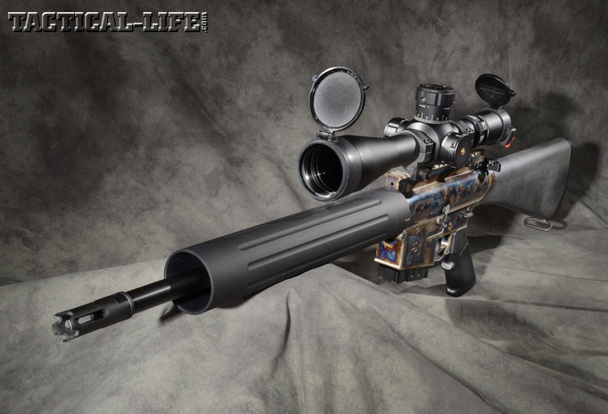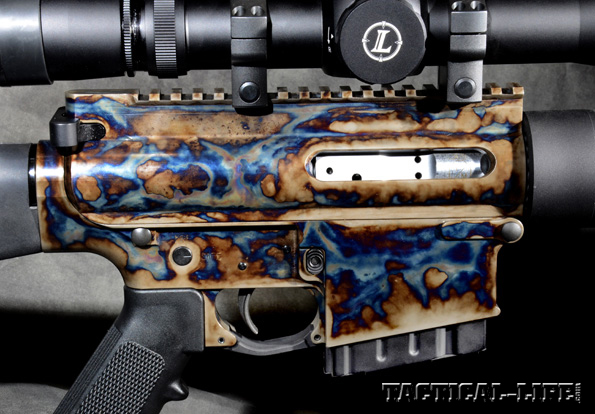In business for 30 years, the Turnbull Manufacturing Company specializes in the restoration of fine vintage rifles, shotguns and pistols. The company also produces several limited-edition firearms of its own, including a reproduction Winchester Model 1886 rifle and the rifle currently under consideration—the TAR-40. Since the TAR-40 is an AR-type self-loading rifle, which is substantially different from other Turnbull products, I asked Robert Chipman of Turnbull about the rationale for the TAR-40. He gave an interesting answer. The company felt that there were buyers of fine rifles who had never owned a “black rifle” and who might be tempted to try an AR were it built handsomely and to the highest standards of craftsmanship, giving it some of the appeal of a classic Winchester lever action.
She’s A Looker!
His answer made quite a bit of sense. The market for AR-type rifles for hunting has broadened dramatically over the last decade, and certainly, ARs are no longer limited to those who like to shoot military-style rifles. And when I looked at the photos of the TAR-40 on the Turnbull website and read the specifications, I saw his point—it should appeal even to lovers of classic Winchesters. For example, the Turnbull’s 8620 carbon-steel upper and lower receivers are beautifully case hardened using Turnbull’s bone charcoal process. The forend, buttstock and pistol grip are made of nicely finished American walnut. Sling swivels are standard. Such features do give the TAR-40 the cachet of a classic Winchester.
Advertisement — Continue Reading Below
She’s A Shooter!
The TAR-40 is a beautiful rifle, but it also incorporates features that will appeal to the shooter. It uses a 16-inch 4150 chrome moly-vanadium barrel with a screw-on muzzle brake. Both barrel and chamber are chrome-lined as an aid to maintenance and accuracy. A carbine gas-operating system with rotating bolt is used, according to Turnbull advertising for smoother recoil. Certainly, I found the recoil quite mild. A Magpul MOE triggerguard is used to allow for shooting while wearing a glove. The question is, will the shooter be wearing a glove to protect the hands in cold weather or to protect the beautiful case hardening from sweaty fingers in summer?
A high-rise Picatinny rail on the upper allows the use of a variety of optics. The TAR-40 uses DPMS and Bushmaster barrels and parts.
Since I do mostly tactical rifle evaluations, all of the precision ARs in .308 caliber that I’ve shot were sniper rifles. Interestingly, the TAR-40 that I received for evaluation was not the version shown on the Turnbull website, but was one containing tactical features. That the TAR-40 is available in a tactical package isn’t surprising, since Turnbull makes each rifle to the customer’s specification. Nevertheless, I hadn’t made a request for any particular feature.
Advertisement — Continue Reading Below
My test TAR-40 has a mid-length gas port and Lothar Walther 18-inch stainless-steel melonite-coated target barrel with a muzzle brake. Its “tactical” features include an aluminum free-float handguard and an A2 stock. Its model designation is TAR10A2FFLW18SS.
Glass Particulars
For testing, I chose the Leupold Mk 4 ER/T M5A2 6.5-20x50mm scope. This is actually an optic that would be better suited to a longer-range rifle such as a .338 Lapua. In fact, I have it to test for the optics chapter in a book I’m doing on .338 Lapua sniper rifles. However, it was sitting on my optics shelf when the TAR-40 arrived, and since it is a premier scope I thought it would be a good one to try on the Turnbull. Just because it goes to 20X doesn’t mean I have to use 20X. This is a First Focal Plane (FFP) scope with Leupold’s excellent TMR reticle. Just as a note to any foreign readers, this is an ITAR (International Traffic in Arms) scope, which requires a Department of State license to export.
Advertisement — Continue Reading Below
Let me take a minute to explain about FFP scopes for those unfamiliar with them. On an FFP variable power scope, the reticle will increase in size as the magnification is increased, causing it to keep the same size relationship to the target. This can be an advantage in low light, but a finer reticle will usually offer better precision for shot placement. As a result, the lower magnification settings will generally make the reticle rather fine—often too fine for me. As a result, I will normally use an FFP variable on 10X or higher. It should also be noted that FFP scopes normally have a dial on the side to adjust parallax, but adjusting it may affect focus, so a fast-focus eyepiece must be used to achieve a clear sight picture. FFP scopes are also easier to use for ranging due to the constant value of the reticle. In simple terms, if a Mil-Dot reticle is used for ranging, on a 2nd Focal Plane scope (SFP), it will have to be used on one magnification setting. On an FFP scope, the Mil-Dots can be used for ranging on any magnification.
This scope includes all of the features that one would expect with a Leupold, including high-quality lens coatings, precision glass, water- and fogproofing, and tough construction. One special feature I like is the M5A2 elevation-adjustment dial with auto-locking. Once an elevation adjustment is set, a button atop the scope must be depressed to change the setting. This prevents its inadvertently getting moved prior to a shot. Though designed as a long-range sniping scope, I felt the Leupold ER/T would allow me to maximize the TAR-40 during testing.
To The Range
Advertisement — Continue Reading Below
My first range impression arose while transporting the TAR-40 from my truck to a shooting bench—it is very heavy. With a loaded 10-round magazine and the Leupold scope attached, weight was around 16 pounds. If you intend to carry this rifle afield you’ll need a good sling. The A2 stock has a built in sling swivel, but there will need to be a mounting point for a front swivel. Had I known it was so heavy, I would have ordered the TAR-40 with a bipod, since the gun is, for me, too heavy to shoot without a rest.
I tested the TAR-40’s accuracy with Black Hills 168-grain HPBT and CorBon 168-grain HPBT match-grade ammo. With both loads I’ve achieved excellent results testing sniping rifles, and I knew that they would allow the TAR-40 to shoot to its potential. If using a low-mounted scope on the TAR-40, I would recommend adding an extended charging handle latch. The one from Power Custom is good and allows for use of the support-side palm to easily operate the charging handle.
Before shooting, I had to first fine-tune the focus so I could see the reticle sharply, then set the scope to 10X to get the reticle a little bigger. I started my zeroing process with CorBon 168-grain match and was immediately impressed with the TAR-40’s accuracy. Two called-flier-tainted groups aside, every group spanned under 1 inch at 100 yards. By the time I had the TAR-40 zeroed, I had shot a couple of .75-inch groups, and a friend who was shooting with me had shot a .5-inch group. There is no doubt that the TAR-40 is as accurate as advertised. Later, at 200 yards, my groups generally fell under 2 inches, and when they didn’t, it was my fault, not the ammunition’s or the rifle’s. With the Black Hills Match ammo, groups were sub-MOA as well.
Advertisement — Continue Reading Below
Trigger pull for the TAR-40 was quite good, though I do have one AR-based sniping rifle that has a lighter crisper pull. Still, the pull allowed for highly precise shooting. For those used to firing AR-type rifles, the TAR-40’s ergonomics will seem normal. However, since the bolt release button is inset under the upper receiver on the left side, those used to smacking it with their palm—as I am—will have to use their thumb. Since I doubt the TAR-40 will be used as a combat rifle, requiring fast magazine changes, this is not an issue. The TAR-40’s weight made recoil virtually unnoticeable.
Considering Turnbull’s intent to produce a fine rifle for those who would like an accurate, well-crafted .308 using the AR system, I think the TAR-40 is a success. The TAR-40 will be purchased for its looks and accuracy, not for use as a combat or a hunting rifle, though it could be taken afield and shot from a stand. The rifle’s list price of $4,995 will narrow the field of buyers to those who can afford to indulge themselves with a rifle that is not expected to be an all-around knockabout “truck companion.” It’s nice to look at and nice to shoot—but it’s on the hefty side! For more, visit turnbullmfg.com or call 585-657-6338.
































